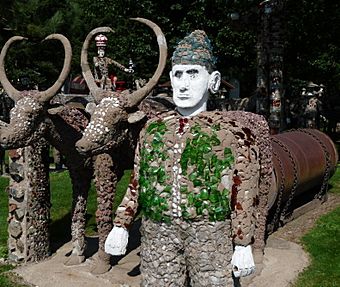Wisconsin Concrete Park facts for kids
Quick facts for kids |
|
|
Wisconsin Concrete Park
|
|

"Mr. Knox and Oxen", a sculpture in the park
|
|
| Location | WI 13 S., Phillips, Wisconsin |
|---|---|
| Area | 18 acres (7.3 ha) |
| Built | 1948 |
| Architect | Smith, Fred |
| Architectural style | Late 19th And Early 20th Century American Movements |
| NRHP reference No. | 05001195 |
| Added to NRHP | October 28, 2005 |
The Wisconsin Concrete Park is a special outdoor art space in Phillips, Wisconsin. It's filled with over 200 unique sculptures. These artworks are made from concrete and decorated with cool things like glass bottles and other items Fred Smith found. Fred Smith, a former lumberjack, started building these sculptures in 1948 after he retired. He didn't have any art training, but he just started creating!
Fred Smith kept making sculptures until 1964. He had a stroke that made him stop working. He once said that the sculptures "came to [him] naturally." He also said, "nobody knows why I made these sculptures, even me."
Contents
What You'll See at the Park
The sculptures show many different things. You'll find people doing everyday activities. These include farming, watching workers, and even people enjoying a drink. Many animals are also shown. Some are wild, while others are helping on a farm.
One famous sculpture shows a team of strong Clydesdale horses. They are pulling a wagon. This was the last sculpture Fred Smith finished before his stroke. You can also spot sculptures of famous people and legends. These include Ben-Hur, Paul Bunyan, and Abraham Lincoln.
The Artist: Fred Smith's Life
Fred Smith was born in 1886 in Price County, Wisconsin. His parents were immigrants from Germany. When he was a teenager, he started working as a lumberjack. This meant he cut down trees for a living.
In 1903, Fred Smith claimed the land where the park is now. Besides working in the woods, he also grew ginseng and Christmas trees on his farm. His first house burned down in 1921. After that, he built the house you see today.
Fred's Unique Home and Tavern
His house looks like a typical Craftsman style home. But it has a special "rock garden room." In this room, Fred built a 23-foot brick trough with running water. It also had a fish pond that sparkled with mica. He even added crosscut saw blades and a rock garden inside!
Later, he added a rock garden outside his house. This was sometime between 1922 and the 1940s. It had raised garden beds in different shapes. In 1936, Fred and two local stonemasons built the Rock Garden Tavern. Here, Fred would tell amazing stories and play music. He would even jump from table to table with bells on his legs, playing a mandolin or fiddle!
Fred started making his concrete sculptures after he retired in 1948. He slowly changed his outdoor rock garden into the amazing concrete park we see today. He continued creating until his stroke in 1964.
Saving the Park: A Community Effort
After Fred Smith passed away in 1976, a big storm hit the park. More than 70% of his sculptures were damaged. But people wanted to save this special place!
The Kohler Foundation helped fix up the park. They then gave it to Price County. Now, it's a county park for everyone to enjoy. Two talented sculptors, Don Howlett and Sharron Quasius, helped restore the artworks. The Wisconsin Concrete Park was added to the National Register of Historic Places on October 28, 2005. This means it's recognized as an important historical site.



